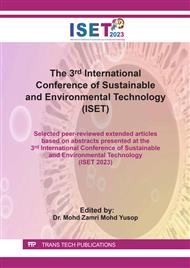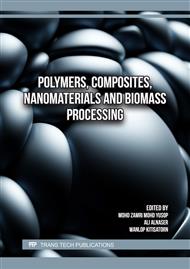[1]
O. N. Syazwani, U. Rashid, M. S. Mastuli, and Y. H. Taufiq-Yap, "Esterification of palm fatty acid distillate (PFAD) to biodiesel using Bi-functional catalyst synthesized from waste angel wing shell (Cyrtopleura costata)," Renew Energy, vol. 131, p.187–196, 2019.
DOI: 10.1016/j.renene.2018.07.031
Google Scholar
[2]
M. E. Borges and L. Díaz, "Recent developments on heterogeneous catalysts for biodiesel production by oil esterification and transesterification reactions: A review," Renewable Sustainable Energy Rev, vol. 16, no. 5, p.2839–2849, 2012.
DOI: 10.1016/j.rser.2012.01.071
Google Scholar
[3]
M. A. Bashir, S. Wu, J. Zhu, A. Krosuri, M. U. Khan, and R. J. Ndeddy Aka, "Recent development of advanced processing technologies for biodiesel production: A critical review," Fuel Process Technol, vol. 227, p.107120, 2022.
DOI: 10.1016/j.fuproc.2021.107120
Google Scholar
[4]
F. E. Kiss, M. Jovanović, and G. C. Bošković, "Economic and ecological aspects of biodiesel production over homogeneous and heterogeneous catalysts," Fuel Process Technol, vol. 91, no. 10, p.1316–1320, 2010.
DOI: 10.1016/j.fuproc.2010.05.001
Google Scholar
[5]
M. Fauziyah, W. Widiyastuti, and H. Setyawan, "Sulfonated carbon aerogel derived from coir fiber as high performance solid acid catalyst for esterification," Adv Powder Technol, vol. 31, no. 4, p.1412–1419, 2020.
DOI: 10.1016/j.apt.2020.01.022
Google Scholar
[6]
R. Liu, X. Wang, X. Zhao, and P. Feng, "Sulfonated ordered mesoporous carbon for catalytic preparation of biodiesel," Carbon N Y, vol. 46, no. 13, p.1664–1669, 2008.
DOI: 10.1016/j.carbon.2008.07.016
Google Scholar
[7]
H. Setyawan, M. Fauziyah, H. S. S. Tomo, W. Widiyastuti, and T. Nurtono, "Fabrication of Hydrophobic Cellulose Aerogels from Renewable Biomass Coir Fibers for Oil Spillage Clean-Up," J Polym Environ, vol. 30, p.5228–5238, 2022.
DOI: 10.1007/s10924-022-02591-2
Google Scholar
[8]
S. Niu, Y. Ning, C. Lu, K. Han, H. Yu, and Y. Zhou, "Esterification of oleic acid to produce biodiesel catalyzed by sulfonated activated carbon from bamboo," Energy Convers Manag, vol. 163, no. 17923, p.59–65, 2018.
DOI: 10.1016/j.enconman.2018.02.055
Google Scholar
[9]
M. Fauziyah, W. Widiyastuti, R. Balgis, and H. Setyawan, "Production of cellulose aerogels from coir fibers via an alkali–urea method for sorption applications," Cellulose, vol. 26, no. 18, p.9583–9598, 2019.
DOI: 10.1007/s10570-019-02753-x
Google Scholar
[10]
L. Zuo, Y. Zhang, L. Zhang, Y. E. Miao, W. Fan, and T. Liu, "Polymer/Carbon-Based Hybrid Aerogels: Preparation, Properties and Applications," Materials, vol. 8, no. 10, p.6806–6848, 2015.
DOI: 10.3390/ma8105343
Google Scholar
[11]
S. Thangalazhy-Gopakumar et al., "Physiochemical properties of bio-oil produced at various temperatures from pine wood using an auger reactor," Bioresour Technol, vol. 101, no. 21, p.8389–8395, 2010.
DOI: 10.1016/j.biortech.2010.05.040
Google Scholar
[12]
C. Yang, J. Liu, and S. Lu, "Pyrolysis temperature affects pore characteristics of rice straw and canola stalk biochars and biochar-amended soils," Geoderma, vol. 397, p.115097, 2021.
DOI: 10.1016/j.geoderma.2021.115097
Google Scholar
[13]
S. Lu and Y. Zong, "Pore structure and environmental serves of biochars derived from different feedstocks and pyrolysis conditions," Environ Sci Pollut Res, vol. 25, no. 30, p.30401–30409, 2018.
DOI: 10.1007/s11356-018-3018-7
Google Scholar
[14]
D. L. Pavia, G. M. Lampman, G. S. Kriz, and J. R. Vyvyan, Introduction to Spectroscopy, 4th ed. California: Brooks/Cole, 2009.
Google Scholar
[15]
A. S. Suryandari, T. Nurtono, W. Widiyastuti, and H. Setyawan, "Hydrophobic Modification of Sulfonated Carbon Aerogels from Coir Fibers To Enhance Their Catalytic Performance for Esterification," ACS Omega, vol. 8, no. 30, p.27139–27145, Aug. 2023.
DOI: 10.1021/acsomega.3c02244
Google Scholar



